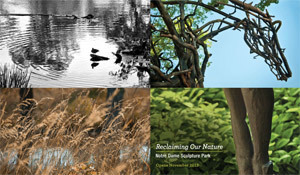
Construction has begun on a new sculpture park on the southern edge of the University of Notre Dame’s campus.
Situated in a wooded, 8-acre dell that lies between the Irish Green and the Compton Family Ice Arena, the new park is a project of Notre Dame’s Snite Museum of Art and the office of the University Architect. It has been designed by the landscape architect Michael Van Valkenburgh, whose prior designs include the Allegheny Riverfront Park in Pittsburgh, Mill Race Park in Columbus, Ind., and Teardrop Park in downtown Manhattan. The park will be completed in late fall.
In addition to its provision of public space for the contemplation and enjoyment of nature and art, the new park will be available as a venue for occasional academic class sessions, poetry readings and musical concerts.
“The Notre Dame Sculpture Park will create an attractive new amenity not only for campus, but also for the local community and for national art aficionados,” said Charles Loving, director of the Snite Museum. “Situated at the front door to campus, this park-like exhibition space will feature internationally renowned artists. The inaugural exhibition will explore the theme of ‘Regeneration of Man and Nature’ utilizing sculptures from the permanent collection of the Snite Museum, some of which were acquired specifically for the exhibition.”
The inaugural theme of regeneration is particularly appropriate for the site, a former landfill with a pond formed by runoff water from adjacent parking lots. Indigenous flora, including trees, shrubs and prairie grass to be planted later in the summer, will help restore the area to its natural state and obviate the need for irrigation, fertilization, chemical spraying and annual pruning.
The installation of the inaugural exhibition of the Notre Dame Sculpture Park will begin this fall, and the featured works will include George Rickey’s kinetic stainless steel “Two Lines Oblique”; “Tracery,” a bronze by Deborah Butterfield; Richard Hunt’s Corten steel “Maquette for Wing Generator”; Stephen DeStaebler’s bronze “Single Winged Figure on Plinth” and Peter Randall-Page’s granite “Little Seed.”
Contact: Charles Loving, 574-631-4711, cloving@nd.edu